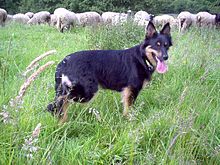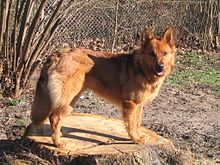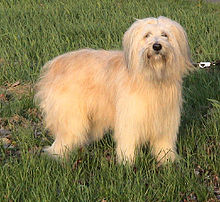Dog breed
| Old German herding dogs | |
|---|---|
 Old German herding dog, landrace: Old German herding dog, landrace:Ost- bzw. mitteldeutsche Gelbbacke ('east- or central-German yellow-cheek') | |
| Other names | Altdeutsche Hütehunde, altdeutsche Schäferhunde |
| Origin | Germany |
| Dog (domestic dog) | |
Old German herding dogs (German: altdeutsche Hütehunde), including old German sheep dogs or old German shepherd dogs (altdeutsche Schäferhunde) are a group of traditional types of working, herding dogs from Germany. They are landraces consisting of working strains of dog, and some of them are the types from which the modern German Shepherd Dog was developed as a standardised breed. The landraces are not recognised by the Fédération Cynologique Internationale, but some have their own standards which are for working ability, not appearance traits.
History
Before the 1890s, any dog used for herding and protecting sheep in Germany was referred to as a "German shepherd dog". The dogs were bred solely for their working ability, with little effort to standardise a particular appearance or create a defined breed of dog.
In 1899, a new formal breed was established by the Society for the German Shepherd Dog. This was selected from among the working shepherd dogs, and became the modern German Shepherd Dog breed.
Many German herdsmen continued to breed their dogs for working ability rather than to the new breed standard, and their remaining non-standardised working dogs were called Altdeutscher Schäferhund (plural with -hunde), literally 'old-German shepherd-dog'.
Under the Verein für Deutsche Schäferhunde (Society for the German Shepherd Dog), the long-haired variant of the German Shepherd Dog for a long time was not accepted. This changed in 2009. Since 2010, the long-haired type has been accepted. So shepherds, farmers, and other owners of the threatened landraces who were attempting to standardise their varieties renamed the altdeutschen Schäferhunde ('old German shepherd dogs') umbrella term to altdeutsche Hütehunde ('old German herding dogs', literally 'old-German herd-dogs'). Other old landraces herding dogs, used for cattle rather than sheep, and which are not ancestors of the modern German Shepherd (including "zott"-coated dogs,, cow-dogs), were also encompassed within the generic category altdeutsche Hütehunde.
Appearance

Today's old German herding dogs differ scarcely from the landraces of the 19th and the early 20th century. Their breed standards (when they exist) require that the animal has to be capable of herding sheep and cattle but seldom prescribe physical appearance, though it is forbidden by these registries to cross-breed them with dogs of other breeds. It is unclear to what extent these standardisation efforts are having an effect. In 2008, the German Society for the Conservation of Old and Endangered Livestock Breeds (GEH) listed these varieties as "extremely vulnerable" to extinction.



The named landraces for which breed standards have been created are divided into sub-groups, first after the livestock they herd, in cow dogs and sheep dogs; second by region (into south-German, or east- and central-German), and more finely by coat type and other features. Most of these have no name in English; approximate translations are shown (note that German capitalises all nouns, but no adjectives, even when derived from proper nouns):
- Kuhhunde, 'cow-dogs'
- Westerwälder (referring to the Westerwald mountains)
- Siegerländer (referring to the Siegerland region)
- Schafhunde, 'sheep-dogs'
- süddeutscher Typ, 'south-German type'
- süddeutsche Gelbbacke, 'south-German yellow-cheek' – black and tan
- süddeutscher Schwarzer, 'south-German black'
- Tiger, 'tiger' – merle-colored coat; common in south Germany, rarer elsewhere
- ost- bzw. mitteldeutscher Typ, 'east- or central-German type'
- ost- bzw. mitteldeutsche Gelbbacke, 'east- or central-German yellow-cheek'
- ost- bzw. mitteldeutscher Schwarzer, 'east- or central-German black'
- ost- bzw. mitteldeutscher Fuchs, 'east- or central-German fox' – reddish)
- harzer Fuchs, 'Harz fox' – reddish sheep-dogs from the Harz)
- zotthaariger Typ – long and raw-coated dogs similar to the Old English Sheepdog or Briard breeds
- Strobel – a south-German type
- Schafpudel, 'sheep-poodle' – a north- and central-German type
- süddeutscher Typ, 'south-German type'
In the 19th century, there existed more of these landraces. Some of them became part of the modern German Shepherd Dog breed, while others became extinct in the course of time. The German: pommerscher Hütehund ('Pomeranian sheep-dog') and the German: Hütespitz ('herding spitz') were also counted among Old German herding dogs. They became extinct in the second half of the 20th century. The Pomeranian landrace was used to strengthen the Great Pyrenees, the Polish Tatra Sheepdog, the Kuvasz and similar now-standardised breeds. It is assumed that the last of the herding spitz landrace, which were mostly white and medium-sized, became part of the foundation stock of the White Shepherd breed. There may be other surviving landraces, not subject to any attempts to establish breed standards.
See also
References
- "Top-10-Fragen" (in German). AAH. Retrieved 16 October 2008.
- "A Profile of the German Shepherd Dog". JustShepherds.com. Archived from the original on 19 February 2009. Retrieved 10 August 2008.
- ^ "Altdeutscher Schaeferhund". Herding on the Web. Archived from the original on 27 March 2013. Retrieved 7 October 2008.
- "History of the Breed". GermanShepherds.com. Archived from the original on 1 June 2008. Retrieved 15 July 2008.
- von Stephanitz, Max; Schwabacher, Joseph (1994). The German Shepherd Dog in Word and Picture. Hoflin Publishing. p. 12. ISBN 978-99932-80-05-7.
- Willis, Malcolm; Bennett, Janet (1992). The German Shepherd Dog: A Genetic History. Maxwell Macmillan International. ISBN 978-0-87605-175-7.
- Die wichtigsten Beschlüsse der Bundesversammlung vom 6.-7. Juni in Kassel. In: SV-Zeitung. Juli 2009. S. 437–438.
- FCI-Standard N°166 - German Shepherd Dog Archived 1 November 2013 at the Wayback Machine (Microsoft Word .doc format). "Double coat & long and harsher outer coat"
- "Westerwälder Kuhhund" (in German). German Society for the Conservation of Old and Endangered Livestock Breeds. Archived from the original on 3 January 2009. Retrieved 8 October 2008.
- Beschreibung der Altdeutschen Hütehunde durch die Interessengemeinschaft Altdeutsche Hütehunde
- Rorem, Linda. "The Old German Shepherd Dog in America". Herding on the Web. Archived from the original on 27 March 2013.
- Mohr, Erna (1969). Ungarische Hirtenhunde (2nd ed.). Lutherstadt-Wittenberg: Ziemsen.
- in 1951 were stated 57 centimetres at the withers and a weight of 23 kg for male dogs. Luther, Wolfgang (1951). "Beobachtungen über angeborene Verhaltensweisen bei einem pommerschen Hütehund". Zeitschrift für Tierpsychologie. 8 (3): 443–448. doi:10.1111/j.1439-0310.1951.tb00185.x.
External links
| Dogs originating in Germany | |
|---|---|
| Hounds | |
| Gundogs | |
| Herding dogs | |
| Earth dogs | |
| Toy dogs | |
| Others | |
| Extinct | |